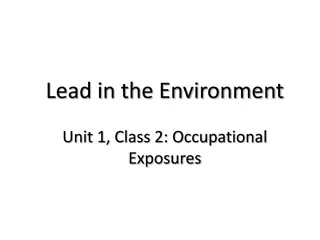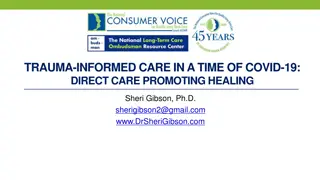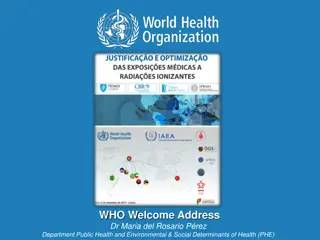Active Tuberculosis Drug Safety Monitoring and Management Training Package 2023
This training package focuses on the safety monitoring and management of active tuberculosis drugs, specifically emphasizing causality assessment in determining adverse reactions. Participants will learn about assessing the likelihood of TB medicines causing adverse events, attributing relationships
3 views • 17 slides
Addressing Double Counting and Design Flaws in Energy Market Exposures
Severe over-collateralization and under-collateralization in the energy market expose participants to financial risks. Flaws in the current EAL design, regarding DC Tie Exports, result in mismatches between calculations leading to excessive collateral calls. Correcting these flaws is crucial to prot
2 views • 14 slides
Overview of Cohort Studies in Epidemiology
Cohort studies are a type of observational study where a group of healthy subjects is followed over time to investigate relationships between exposures and outcomes. They provide valuable insights into disease development and risk factors, offering advantages like assessing multiple exposures and en
0 views • 21 slides
Division of Environmental Health Sciences: Improving Public Health through Research and Education
The Division of Environmental Health Sciences aims to enhance individual and community health by conducting research, identifying risks, reducing hazards, informing policies, and providing interdisciplinary education. Their projects cover a wide range of environmental health issues, from infectious
4 views • 10 slides
Mystery Case Study: 75-Year-Old Male with Fever and Altered Mental Status
A 75-year-old male with a history of multiple animal exposures presented with fever, altered mental status, headache, and diarrhea. Physical exam revealed vital signs within normal limits, and labs showed various results including negative infectious disease workup but pending further tests. Imaging
0 views • 11 slides
Understanding Off-Balance Sheet Items in Banking Activities
Off-balance sheet items refer to activities that are assets or liabilities of a company but do not appear on the balance sheet. In banking, these can include loans given to borrowers, securitization, guarantees, and other contingent facilities. Learn more about how off-balance sheet exposures impact
0 views • 6 slides
Evolving Security Practices in DevOps: A Holistic Approach
Explore the evolution of security practices within the DevOps landscape, from debunking the myth of DevSecOps non-existence to embracing a shift-left mentality. Discover the challenges of traditional security views, the importance of continuous security integration, and the impact of delivery exposu
1 views • 25 slides
Understanding Cross-Sectional Studies: Overview, Strengths, and Weaknesses
Cross-sectional studies are observational study designs that capture data from a population at a specific point in time. This snapshot approach allows for the simultaneous measurement of outcomes and exposures without follow-up. While quick and cost-effective, these studies have limitations such as
1 views • 14 slides
Types of Bias in Epidemiological Studies
Bias in epidemiological studies can arise from misclassification of observations and exposures, leading to incorrect associations between variables. Observation bias, misclassification bias, and non-differential misclassification can impact the accuracy of study results, either minimizing difference
1 views • 11 slides
Understanding Disability: Impairments, Activity Limitations, and Participation Restrictions
Disability is a condition that affects the body or mind, resulting in difficulty in performing activities and interacting with the environment. There are various types of disabilities, each impacting individuals differently. The term "people with disabilities" encompasses a diverse group with varyin
0 views • 19 slides
Understanding Rabies: Causes, Symptoms, and Prevention
Rabies is an acute and highly fatal viral disease of the central nervous system, caused by Lyssavirus type 1. It is a zoonotic disease that affects warm-blooded animals such as dogs, cats, bats, racoons, skunks, and foxes. The disease is primarily transmitted to humans through the bite of a rabid an
2 views • 6 slides
Understanding Radiation Dosimeters for Occupational Exposure Monitoring
Radiation dosimeters, like Thermoluminescent Dosimeters (TLD), are vital tools for measuring occupational exposure to ionizing radiation. TLDs work by storing energy from radiation exposure in crystals, which is later released as light when heated for measurement. Dosimeters are assigned to specific
0 views • 18 slides
Promoting Occupational Health in the Construction Industry
Promoting occupational health in the construction industry is crucial to prevent occupational lung diseases. Safe Work Australia reports alarming statistics of occupational illness-related deaths. The Breathe Freely Australia program emphasizes the importance of controlling exposures to prevent dise
0 views • 7 slides
Understanding Antibiotic Resistance in Healthcare Settings
This case study follows a 64-year-old female presenting with symptoms of acute pyelonephritis, highlighting the challenge of emerging antibiotic resistance. Despite sensitive urine cultures, the patient's condition worsened, shedding light on the importance of identifying risk factors beyond traditi
1 views • 62 slides
Harnessing Syndromic Surveillance Systems for Climate-Related Outcomes
Utilizing syndromic surveillance systems can provide valuable insights into the impact of climate change on health outcomes. This document aims to guide users on identifying outcomes, creating case definitions, combining data sources, and engaging with partners for effective climate and health surve
1 views • 28 slides
Understanding Poisonous Plants and Their Effects on Humans
Poisonous plants can have deleterious effects on individuals, leading to severe consequences and even death if not managed properly. These plants produce toxins that interfere with the body's essential functions, ultimately causing impairment and potential fatality. Recognizing the grades of poisoni
0 views • 11 slides
Comprehensive Overview of Logistics Risk Management & Insurance
With over 30 years of experience in underwriting transportation and logistics insurance, this content delves into the intricacies of logistics risk management and insurance. It covers the definition of logistics, regulatory aspects of freight brokerage, operational goals in logistics, insurance cove
0 views • 23 slides
Understanding Cataracts: Causes, Effects, and Treatment
Cataract is a common eye condition characterized by clouding of the lens, leading to gradual vision loss. It is the third leading cause of preventable blindness and is typically treated with surgery. Various factors, such as aging, trauma, and toxic exposures, contribute to the development of catara
0 views • 34 slides
DTSC Proposal to List Nail Products Containing Methyl Methacrylate (MMA)
The Department of Toxic Substances Control (DTSC) is holding a public workshop to discuss listing nail products containing Methyl Methacrylate (MMA) as a priority product due to potential exposures and adverse impacts. The presentation covers the scope of the product, hazard traits, exposure potenti
0 views • 47 slides
Understanding Human Parasites: Laboratory Testing, Neglected Tropical Diseases, and More
Explore the world of human parasites through laboratory testing for intestinal, blood, and tissue parasites. Learn about neglected tropical diseases, common parasitic disease exposures, Texas notifiable conditions, and additional parasites to be aware of. Traditional parasitology techniques involvin
0 views • 19 slides
Lead Awareness and Safety Training Overview
This training presentation provides valuable information on lead, including its properties, where it can be found, and occupational exposures. It discusses the risks associated with lead exposure and OSHA standards to ensure worker safety. The content covers essential topics such as what lead is, it
0 views • 62 slides
Lead Exposure Through the Ages: Occupational Dangers and Historical Perspectives
Explore the historical use of lead, from its early extraction and toxic effects to occupational exposures in pre-industrialized times. Discover how artisans and miners in ancient civilizations like Rome faced lead poisoning risks, as documented by physicians throughout history. Learn about the occup
1 views • 10 slides
Bloodborne Pathogens Exposure: HIV Post Exposure Prophylaxis Regimen
Take immediate action for exposure to bloodborne pathogens like HIV and Hepatitis C through a post-exposure prophylaxis (PEP) regimen. Administer PEP within 48 hours for increased-risk exposures like needle sticks or contact with infected fluids. Coordinate evacuation if needed and conduct Rapid Dia
0 views • 5 slides
Trauma-Informed Care in a Time of COVID-19: Direct Care Promoting Healing
Understanding trauma and its impact in the context of COVID-19 is crucial for providing effective care. Individual responses to trauma are multifaceted, influenced by various pre-pandemic circumstances and exposures encountered during the pandemic. Implementing trauma-informed care practices is esse
0 views • 41 slides
Importance of Fall Protection Systems in Workplace Safety
Fall protection systems play a crucial role in preventing injuries and fatalities caused by falls at the workplace. Understanding the anatomy of a fall, statistics on fall-related incidents, and the various philosophies of fall protection can help companies plan and implement effective fall protecti
0 views • 50 slides
Understanding DNA Methylation and Cadmium Exposure in Utero: An Epigenetic Analysis
Explore the complex relationship between DNA methylation and in utero exposure to cadmium through a set of informative slides created by Dana Haine, MS. Learn about the impacts of DNA methylation on gene expression and how changes in methylation levels can lead to gene silencing or activation. Disco
0 views • 8 slides
Workshop on Justification and Optimization in Medical Exposures for Portuguese-speaking Countries
Welcome to the workshop organized by WHO focusing on improving health services quality and radiation safety in medical care. The event will cover advancements in health technology, challenges in radiation medicine, and the importance of collaboration for enhancing healthcare worldwide.
0 views • 5 slides
Comprehensive Recommendations for Radiological Protection Education and Training
This document provides detailed guidelines for educating and training healthcare professionals involved in diagnostic and interventional procedures using ionizing radiation. It emphasizes the increasing importance of radiation protection knowledge in light of the growing number of such procedures. T
0 views • 38 slides
Understanding Analysis: Insights and Challenges in Advanced Mathematics
Dive into the world of advanced calculus and real analysis with insights from Dr. Wai W. Lau’s course at SPU. Explore the challenges and rewards of mastering calculus, the importance of multiple exposures to the subject, and the skills needed to excel in mathematical proofs. Gain valuable perspect
0 views • 31 slides
Understanding Children's Eating Behavior and Taste Preferences
This presentation delves into common eating behaviors and challenges in young children, including the development of taste preferences. It highlights the impact of prenatal and early childhood exposures on food acceptance, discusses the role of parental feeding practices, and emphasizes the importan
0 views • 27 slides
Historical Occupational Exposures to Lead in Pre-Industrialized Times
Occupational exposure to lead in pre-industrialized times dates back to ancient eras, with Romans and artisans using lead in various applications. Lead toxicity was observed early on, with artisans like goldsmiths and artists being at risk. Physicians in the Renaissance era recognized the dangers of
0 views • 10 slides
Understanding Latex Exposure: Routes and Risks
Latex exposure can occur through various routes such as contact with NRL products, aerosilized latex from glove powder, and inadvertent exposures leading to sensitization and allergic reactions. Transfer of latex allergens to food by food handlers wearing latex gloves can also pose risks, as shown i
0 views • 12 slides
Understanding the UAF Chemical Hygiene Plan (CHP) Roles and Responsibilities
The UAF Chemical Hygiene Plan (CHP) is essential to protect lab personnel from hazardous chemical exposures. It outlines roles and responsibilities for the Principal Investigator (PI), lab employees, and Chemical Hygiene Officer (CHO). The PI is responsible for training workers, maintaining equipmen
0 views • 22 slides
Chemical Hygiene Plan & Laboratory Safety Overview
This document outlines the Chemical Hygiene Plan and Laboratory Safety procedures, including responsibilities, standard operating procedures, controlling chemical exposures, and the use of engineering controls like chemical fume hoods. It serves as a guide for maintaining a safe working environment
0 views • 90 slides
Understanding Health Risks in Reclaimed Water and Water Reuse
Exploring the microbial aspects of reclaimed water and wastewater reuse is crucial for public health. Pathogenic microorganisms present in wastewater, such as bacteria, viruses, and parasites, can lead to gastrointestinal and systemic illnesses in humans. Proper removal and inactivation of these pat
0 views • 25 slides
Understanding Fiduciary Liability Exposure of Design Professionals
Design professionals may potentially owe a fiduciary duty to their clients, which goes beyond the standard duty of care. This duty includes acting in good faith, trust, and candor for the benefit of the client. Recognizing the legal exposures associated with assuming fiduciary duties is crucial in c
0 views • 40 slides
ERCOT Market Credit Manager Proposal Analysis
This document outlines EAL change proposals scenarios for ERCOT Market Credit Manager, including definitions of invoice exposures, current EAL formulas, and various scenarios affecting the calculation. It covers invoice exposure definitions, current EAL formula versus scenarios #1, #1a, and #1b, as
0 views • 11 slides
Hepatitis C Surveillance Report: Trends and Risk Factors
The CDC National Notifiable Diseases Surveillance System data reveals hepatitis C trends, reported cases per 100,000 population across age groups, gender, and ethnicity. Risk factors such as injection drug use, sexual contact, multiple sex partners, and occupation exposures are identified and discus
0 views • 7 slides
Recommendations for Updating Occupational Health Questionnaire (OHQ) Content
Subcommittee recommendations include retaining and expanding the list of hazards and materials on the current OHQ, emphasizing task-related exposures and worker input. Bulletin 16-03 highlights the importance of linking medical conditions to specific tasks, suggesting revisions to meet standards. Ad
0 views • 7 slides
Analysis of Fall 2021 COVID-19 Exposures and Student Learning Preferences
The Fall 2021 data reveals potential COVID-19 exposures, with a significant number of students, faculty, and staff affected. Online/remote learning was prevalent, with a higher enrollment in online sections. Students also showed a preference for online instruction in Spring 2022. Data further highli
0 views • 8 slides







































